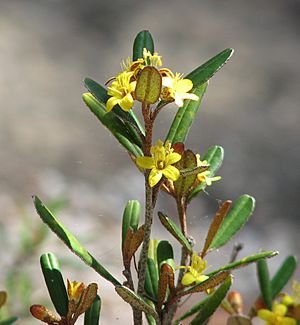Phebalium whitei facts for kids
Quick facts for kids Phebalium whitei |
|
|---|---|
 |
|
| In Maranoa Gardens | |
| Conservation status | |
| Scientific classification | |
| Genus: |
Phebalium
|
| Species: |
whitei
|
| Synonyms | |
|
|
Phebalium whitei is a small, unique shrub found only in south-east Queensland, Australia. It's known for its branches covered in shiny silver and rusty-coloured scales. Its leaves are tough and shaped like ovals. This plant also has bright yellow flowers that grow in small clusters at the ends of its branches.
Contents
What Phebalium whitei Looks Like
Phebalium whitei is a bush that usually grows to about 1 meter (3 feet) tall. Its branches are covered with cool, shiny scales that can be silver or a rusty colour.
- Leaves: The leaves are strong and feel a bit like leather. They are shaped like long ovals, usually between 10 and 70 millimeters (about 0.4 to 2.7 inches) long and up to 15 millimeters (about 0.6 inches) wide. They grow on a small stalk called a petiole, which is about 3 to 6 millimeters long. The top of the leaf is smooth and hairless (called glabrous), while the bottom is covered with silvery scales.
- Flowers: The bright yellow flowers grow in small groups called umbels. These umbels don't have their own stalks (they are sessile), and each group can have up to six flowers. Each flower sits on a short, thick stem called a pedicel, about 2 to 4 millimeters long. The base of the flower, called the calyx, is shaped like half a ball and is covered in silvery and rusty scales. The petals are bright yellow, about 9 millimeters long and 3 millimeters wide. They also have silvery and rusty scales on their backs.
This plant usually blooms, or flowers, from June to September.
How Phebalium whitei Got Its Name
This special plant was first described in 1939 by a scientist named Cyril Tenison White. He called it Phebalium squamulosum var. grandiflorum. The first sample of the plant used for this description was collected in 1932 in a place called Wyberba.
Later, in 1970, another scientist named Paul Graham Wilson decided that this plant was unique enough to be its own species. He officially named it Phebalium whitei in a science journal called Nuytsia. He chose the name whitei to honor C.T. White, who first studied the plant.
Where Phebalium whitei Lives
You can find Phebalium whitei in the Stanthorpe area of south-east Queensland. It likes damp places, often growing in cracks in large, flat granite rocks or along the banks of creeks. Sometimes, it can also be found in open areas with low-growing plants, known as heathland.
Protecting Phebalium whitei
Phebalium whitei is considered a "vulnerable" species. This means it's at risk of disappearing if we don't protect it. Both the Australian Government, under the Environment Protection and Biodiversity Conservation Act 1999, and the Queensland Government, under the Nature Conservation Act 1992, list it as vulnerable.
The biggest dangers to this plant are:
- Wrong Fire Management: Fires that happen too often or at the wrong time can harm the plants and stop them from growing back properly.
- More Visitors: As more people visit Girraween National Park where the plant grows, there's a risk of accidental damage to the plants or their habitat.
See also
 In Spanish: Phebalium whitei para niños
In Spanish: Phebalium whitei para niños


